Executive Summary
Financial advisors and investment management consultants have long recognized that different fund managers have different investment styles. Some focus on stock picking, while others rotate amongst sectors or asset classes based on macroeconomic bets. And those who don’t think active managers can do any of those things successfully simply buy index funds.
In recent years, though, Martijn Cremers and Antti Petajisto have published research suggesting that many active managers may be closer to an index fund that their investors realize. These “closet indexer” funds can be identified by their low Active Share – a measure created by Cremers and Petajisto to measure the extent to which a portfolio’s holdings deviate from its underlying benchmark, which appears to do a better job than tracking error at identifying which fund managers are really making active bets (or not).
And the Active Share research finds that closet indexers really do tend to underperform. Of course, the result that isn’t entirely surprising, as in general index funds are expected to underperform their benchmark by the amount of their fees, and an actively managed fund with a higher active management fee that really just holds the benchmark anyway would simply amount to an unusually expensive index fund.
Which means Active Share itself can be an effective way to evaluate the appropriateness of an investment manager’s fee in the first place. Funds that have low Active Share and resemble their benchmark will behave like index funds, and should charge index-fund-like fees. By contrast, funds that have higher Active Share – which are taking a larger portion of active portfolio bets – at least have the potential to outperform their higher active management fees. Though ultimately the jury is still out about whether high Active Share funds really outperform on average, or are simply an indicator of which funds might be able to outperform!
The Research on Active Share by Cremers and Petajisto
In 2009, Martijn Cremers and Antti Petajisto released a study entitled “How Active Is Your Fund Manager? A New Measure That Predicts Performance.” In the paper, the authors introduced the concept of “Active Share”, a measurement intended to identify the extent to which an active portfolio manager is actually deviating from his/her underlying benchmark and making “active” portfolio bets.
The authors measured this by decomposing an active manager’s portfolio into its benchmark, and a series of implied long/short positions representing the portfolio’s deviations from that benchmark. Thus, for instance, an investment in the S&P 500 that substitutes out Apple’s 2.91% stock weighting and uses the proceeds to buy extra Amazon stock instead would be treated as a position in the S&P 500 plus a 2.91% “short” position in Apple and a 2.91% long position in Amazon (given that Apple has an approximate component weighting of 2.91% in the S&P 500). Notably, the actual holdings would be 0% in Apple and 4.44% in Amazon (including its 1.53% “normal” weighting and the 2.91% reallocated from Apple), but the “Active Share” components would be the benchmark deviations: the “extra” 2.91% in Amazon and the “missing” 2.91% shortfall in Apple.
More generally, Active Share is calculated by adding up how much each portfolio position’s weighting differs from the benchmark (across each holding in the portfolio), and dividing by 2 (to ensure the long and short differences aren’t double-counted).
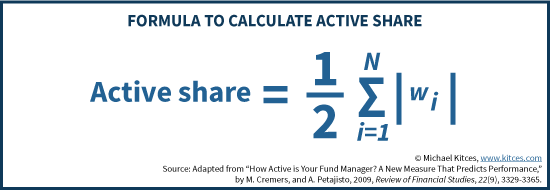 D.>>>
D.>>>
In the formula above, wi is the actual weighting of the investment minus the target weighting of the benchmark (wi,,fund – wi,benchmark), and the exercise is then repeated for the total of all N investments in the portfolio.
Thus in our S&P-500-With-Apple-Switched-To-Amazon example, the portfolio’s Active Share would be 2.91% (amount of missing Apple) + 2.91% (amount of extra Amazon) + 0% (for the other 498 stocks with no deviation) = 5.82% / 2 = 2.91%, correctly reflecting that 97.09% of the portfolio is simply the other 498 stocks of the S&P 500 precisely overlapping their benchmark, and the last 2.91% of the portfolio is what differs (by underweighting one stock and overweighting another).
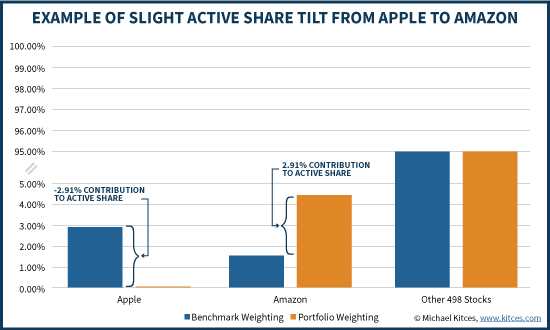
Similarly, if the active manager sold half the stocks in the S&P 500 to buy extra of the other half, the active share would be 50% (assuming equal weights of each), because exactly half the portfolio would still match the benchmark, while the other half would be different. In the extreme, if the S&P 500 manager took the portfolio entirely to cash, or to small cap stocks not in the S&P 500, the active share would be 100%, indicating that none of the holdings have any overlap to the S&P 500 benchmark and 100% of them are different “active” bets.
Benefits Of Active Share Vs Tracking Error
The significance of this new form of evaluating active managers is that it appears to be more effective than “just” measuring tracking error, or the difference in performance between the portfolio and the benchmark. The reason in part is that different types of active management will produce different levels of tracking error, especially in the short term.
For instance, a portfolio that eliminates half the stocks in the S&P 500 (and overweights the other half) but remains diversified across sectors will likely have a low tracking error (as it’s still well diversified and likely to produce large-cap-like performance). A portfolio that eliminates half the sectors in the S&P 500 (with equal weightings) will end out with a significantly higher active share, simply because sectors deviate from the S&P 500 more than a diversified portfolio of half the S&P 500 stocks.
Yet both portfolios have made the same magnitude of active bets by altering their holdings from the underlying benchmark – a distinction that tracking error misses, but Active Share would (correctly) capture. In turn, combining both a look at tracking error and Active Share allows active managers to be characterized into four distinct types.
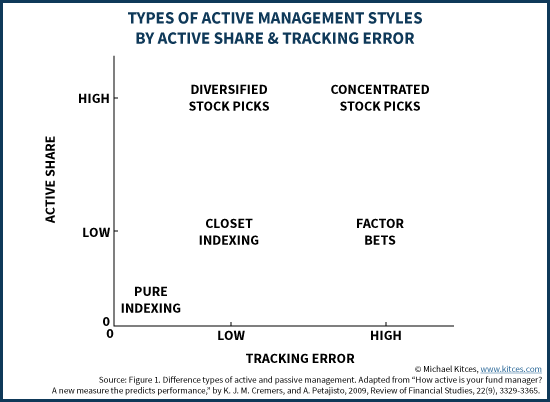
And in fact, when the authors went one step further, and actually measured the performance of active mutual funds segmented by their Active Share (using available data from 1990 to 2003), they found that the funds with the highest active share outperformed (by 1.13% to 1.15% per year net of expenses), while the funds with the lowest active share underperformed (by a whopping -1.42% to -1.83% per year after expenses). Even though tracking error alone had no predictive value on under- or outperformance.
Closet Indexers And The Underperformance Of Low Active Share
When first published, the Active Share research from Cremers and Petajisto generated significant industry buzz – and their paper remains one of the top-100 downloads of all time on SSRN – because of both the statistically significant outperformance of high-Active-Share funds, and also the statistically significant underperformance of low-Active-Share funds. In other words, the research was “doubly predictive” in both directions.
In the context of the low Active Share funds, this is entirely understandable. After all, a portfolio with 0% Active Share is, by definition, simply the holdings of the benchmark itself, in identical weightings. In other words, it is an index fund. And since index funds would be expected to generate gross returns equal to the index, and net returns equal to the index reduced by the expense ratio (and other transaction costs) of the fund, it’s not entirely surprising that an active fund manager charging active manager fees but holding the index will just end out underperforming by even more.
Even a fund with relatively “low” Active Share – which Cremers and Petajisto characterize as funds with Active Share of just 20% to 60% - were significantly less likely to outperform. After all, a fund that has “just” 30% Active Share means that 70% of the fund is the benchmark… which means generating any alpha requires that 30% slice to outperform by enough to cover the fees on both that 30% and the other 70% - which is a hefty cost burden for only a small slice of the portfolio.
Or viewed another way, buying a fund with low Active Share means you’re paying an active manager his/her fee for the whole portfolio for what is actually largely an index fund (that could have been purchased directly at a lower cost) and just a small portion of true active management. Cremers and Petajisto characterized these managers as “closet indexers” – given that their high overlap to the benchmark is often hidden from view (“in the closet”, only revealed by Active Share measurements), and suggest it’s a fund type to categorically avoid.
Is High Active Share Really Predictive Of Outperformance?
One of the still-debated aspects of the Cremers and Petajisto research on Active Share is that not only were low-Active-Share “closet indexers” shown to underperform, but high Active Share managers were shown to outperform as well.
As noted above, the fact that active managers aren’t likely to outperformance with low Active Share is a clear mechanism – mathematically, it’s difficult to outperform a benchmark net of fees when most of the portfolio itself simply is that benchmark. However, it’s less clear whether or why higher active share managers would automatically or naturally outperform.
After all, in the aggregate, the reality is still that active management is and must be a zero-sum game; for every buyer there is a seller, and every outperformer must have a matching underperformer, for their sum total to equal the market itself (before fees). And given that index funds by definition will be the market – and not deviate from it – in theory the sum total of Active Share funds should still contain an equal degree of winners and losers, to average out to the market as a whole.
Of course, the caveat to this argument is that (active) mutual funds are not the sole active participants in the markets, where there are also individual investors, and other institutional investors. It is at least conceivable that actively managed mutual funds with high Active Share do somehow outperform as a group, by generating net positive alpha from some other subgroup of investors that have a net negative alpha in the aggregate.
Yet a deeper dive into the data suggests this is not the case, either. The issue is that it turns out that while Cremers and Petajisto found that higher Active Share funds outperform lower active share funds on average, in part that’s because the higher active share funds were disproportionately comparing themselves against mid- and small-cap benchmarks that happened to perform worse over this time period in the first place. In other words, it wasn’t a matter of high Active Share funds beating low Active Share funds, per se, but that high Active Share funds happened to have easier benchmarks to beat over this time period.
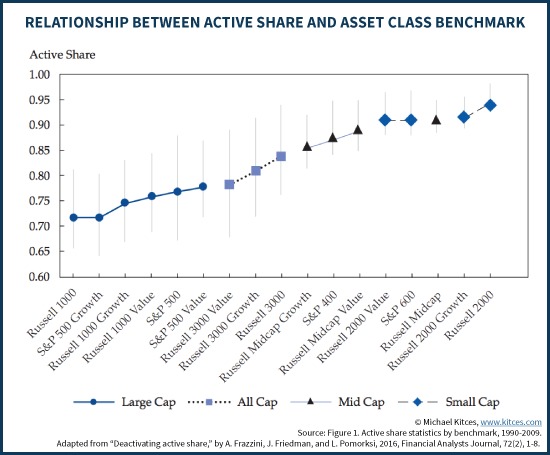
In fact, once the results were adjusted to decompose the differences in actual returns versus the differences in the benchmarks, Frazzini, Friedman, and Pomorski of AQR found that higher Active Share was not actually predictive of outperformance (and notably, they literally used Cremers and Petajisto’s own publicly available data to do the analysis, though Petajisto subsequently responded to raise the question of AQR's approach of using four-factor alphas was the best to evaluate outperformance).
On the other hand, the AQR authors actually did find some outperformance in the highest Active Share funds – after adjusting for benchmarks, the stock picker funds actually outperformed by an average of 2.71% and generated an average of 0.93% alpha. With the limited number of years in the data set, it wasn’t statistically significant.
But that doesn’t actually prove Active Share is not predictive of outperformance, only that we don’t have enough data points to validate that it is predictive of these levels of outperformance. On the other hand, it’s also possible that additional data would simply give more high-Active-Share funds a chance to average out to less outperformance (given the theoretical zero-sum nature of active management in the aggregate).
Active Share And Investment Management Fees
Notwithstanding the debate about whether high Active Share itself outright predicts investment outperformance and alpha (or not), Active Share nonetheless remains relevant as at least a factor for consideration when evaluating investment managers and their investment fees.
First and foremost, both the AQR research and the Cremers and Petajisto (along with Petajisto’s follow-up study in 2013) all find that low Active Share funds – i.e., “Closet Indexers” – are underperforming their benchmarks net of fees. At best, the low Active Share funds aren’t taking enough “good” and winning investment bets to outperform their fees. At worst, they’re actually so close to the index, that it’s not mathematically possible for the small number of non-benchmark holdings to outperform by enough to make the fund as a whole generate positive alpha. In other words, with low Active Share the investor is paying an active management fee for an active manager who couldn’t possibly outperform, even if all their active bets are right, because there aren’t enough active bets!
[Tweet “Low Active Share implies the fund manager can’t possibly outperform the cost drag.”]
The key point here is not merely that a low Active Share fund isn’t likely to outperform its benchmark – after all, an Index fund itself isn’t expected to outperform either. Instead, the concern is paying an active management fee for a closet indexer who has little realistic potential for a favorable result (compared to just buying a cheaper index fund directly instead). By contrast, high Active Share doesn’t necessarily indicate whether the fund’s performance will be better or worse than the benchmark, but at least it means the active manager has a shot at outperforming the drag of his/her fees!
And notably, Active Share is arguably worth looking at not only initially with an investment manager to evaluate the appropriateness of the investment management fee, but also on an ongoing basis as well. After all, the reality is that an active manager who has high Active Share at one point might not continue to maintain high Active Share in the future. That could simply be because, for a limited period of time, he/she doesn’t see any unique investment opportunities, and is taking shelter by owning the benchmark until the next opportunity arises. But it’s also possible that the investment manager is shifting to become a closet indexer later – which, ironically and sadly, can actually be a good personal income and career strategy for an active manager who happens to get lucky with outperformance early in his/her career (as it can take years of closet indexing with modest underperformance to lose the benefit of an initially-good track record)!
Fortunately, Cremers and Petajisto do find that the Active Share of an individual fund is extremely persistent over time. Which means the low Active Share funds to be avoided are likely to persist as such, and the higher Active Share funds – if desired in the first place – are at least likely to remain as such, too. Which means at least most managers who are truly “active” tends to stay that way. On the other hand, the researchers also find that in the aggregate the percentage of high-active-share funds has been declining since the 1980s. While it’s unclear if the shift is because previously-active managers are getting less active, or simply because new fund managers over time are making fewer active bets, the trend of closet indexing (funds with 20% to 60% active share) has been on the rise. (In the chart below, funds with <20% active share generally are index funds themselves, which have also been on the rise lately.)
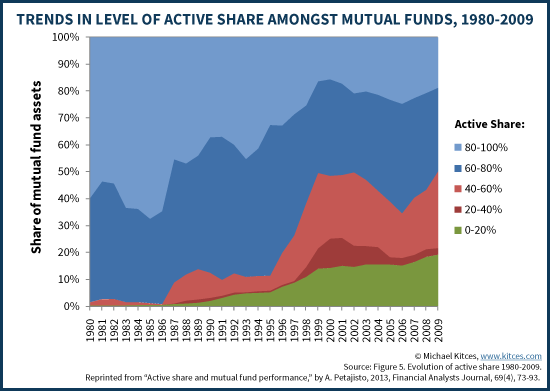
In the end, the bottom line is that while Active Share may not necessarily be an outright predictor of outperformance, it certainly provides valuable descriptive detail about a fund or investment manager themselves, allowing the advisor (or investor) to reflect on whether the active manager is at least trying to earn back his/her investment management fee. For those who don’t have faith in active managers in the first place, an index fund will likely be preferable anyway, but for those who do want to pursue an active management strategy, Active Share at least makes it clearer whether the fund manager really is making “active” decisions to deviate from a benchmark in a manner that can produce outperformance net of fees.
Michael’s Note: For those who want to look up the Active Share for any particular fund – and/or to track it over time – the measure is now available in a number of advisor investment analytics tools, in addition to a standalone website that Cremers offers for free called ActiveShare.info as well (though data is only reportedly updated annually).
So what do you think? Do you measure or monitor the Active Share of investment managers? What role do you think Active Share should play? How do you identify or track Active Share on an ongoing basis? Please share your thoughts in the comments below!





If you want to quantify the appropriate fee level to pay for an investment strategy at a given level of active share, or quantify the fee hurdle for the active portion of the portfolio, we have done some research on that, here: http://www.sellwoodconsulting.com/how-we-use-active-share-to-recommend-better-equity-portfolios/. Hope you find it useful.
I think a more meaningful metric is the active share of the whole portfolio. Suppose a company divides the S&P500 into 5 mutual funds, each with 100 companies. Each of the mutual funds would have a high active share. This in turn might allow the mutual fund provider to charge high fees. Yet, taken together my portfolio would have a zero active share as it is must the S&P500 which I can get for 5 basis points.
Anyone know what the paid analytics tools are?